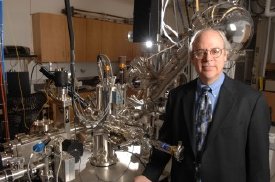Jan 26 2010
University of Chicago chemists published an article in the Journal of Chemical Physics three years ago that described an early step in the process for efficiently converting methane into synthesis gas, which is useful for producing liquid fuels and hydrogen.
 Steven Sibener, the Carl William Eisendrath Professor in Chemistry and the James Franck Institute at the University of Chicago, heads a new multi-university center for chemical innovation, funded by the National Science Foundation.
Steven Sibener, the Carl William Eisendrath Professor in Chemistry and the James Franck Institute at the University of Chicago, heads a new multi-university center for chemical innovation, funded by the National Science Foundation.
Such developments could be critical if the nation is to take better advantage of its abundant methane reserves, said Steven Sibener, the Carl William Eisendrath Professor in Chemistry and the James Franck Institute, whose research group conducted the study. Now Sibener and his associates at four partner universities have established a center for chemical innovation to pursue a broader range of similar research aimed at spurring innovation and economic competitiveness. A $1.5 million grant from the National Science Foundation supports the work.
The new Center for Energetic Non-Equilibrium Chemistry at Interfaces (CENECI) is a team effort of UChicago, the Massachusetts Institute of Technology, Montana State University, Northwestern University and the University of Wisconsin-Madison. Additional partners who endorsed the center proposal are Argonne National Laboratory, Cabot Microelectronics Corporation of Aurora, Ill., and the Museum of Science and Industry in Chicago.
“The people we’ve grouped together at these five schools are acknowledged leaders in the kind of science that was important for successfully tackling this challenging class of problems,” said Sibener, who heads the center.
Energetic chemical reactions
The new center will explore the chemical reactions that unfold under conditions infused with more energy than would normally occur. “One hopes to find new chemistries or more efficient ways of doing known processes,” Sibener said.
The syngas experiments are but one example of non-equilibrium chemistry. In the experiments, the UChicago team collided beams of molecules traveling at supersonic speeds onto a modestly heated metal surface. The high-energy collision breaks the bonds between the methane molecule’s carbon atom and its hydrogen atoms, an important step in the process of turning methane into syngas. Complementing this, the catalyst held at modest temperatures ensures high selectivity in subsequent surface reactions.
The NSF center for chemical innovation will pursue three research themes: new chemical transformations and catalysis under energetic conditions; materials growth, initially focusing on diamond growth for technological applications; and reactions in liquids.
“I am hopeful and enthusiastic about the center,” said Cliff Spiro, Vice President of Research and Development at Cabot Microelectronics. “In my 30 years of industrial research across many disciplines, this is a theme that comes up time and time again, and is truly fertile ground for breakthroughs of real significance.”
Impatient for discovery
Spiro said that when Sibener first told him about the center’s mission, “I couldn’t stop peppering him with examples from my world of combustion, diamonds, metallurgical coatings, optical films, and semiconductor processes. I can’t wait to learn of their discoveries.”
The new center will offer education and outreach activities in addition to research.
In the outreach component, the five CENECI institutions will provide chemistry education programs to underrepresented Hispanic and African-American K-12 students in Chicago, Madison and Boston, as well as to Native American students in Montana (K-14, including tribal colleges).
The center also will arrange collaborative research exchanges, giving graduate students and postdoctoral researchers the opportunity to receive co-mentoring from a senior scientist who supervises a CENECI laboratory at one of the other institutions. Other opportunities target undergraduate participation.
In addition to the CENECI funding, Sibener also recently received two Department of Energy grants to support other projects. One of them is a three-year, $885,000 grant for Single Investigator and Small-Group Research to study emergent behavior in chemistry and physics.
Interactive behavior
The study’s goal is to understand how new chemical and materials behavior emerges from the various interactions of their atoms and molecules. “Sometimes when you put things together they behave differently than when they’re alone,” Sibener explained.
Sibener’s team will analyze chemical reactions as they occur, molecule by molecule. The researchers then will change the chemical environment for small groups of molecules sitting on an atomically tailored surface to see if they react differently than would an isolated molecule.
Another step would entail attempting to influence the growth of chiral materials—materials that are right- or left-handed at the molecular level—which determines their optical properties and alters their chemical reactivity.
The third grant is extending the Sibener group’s collaboration with Lance Cooley and other researchers at Fermi National Accelerator Laboratory. Together they seek to improve the fundamental understanding of superconducting materials needed for advancing linear collider technology.
Sibener received notification of all three grants within a recent six-week period. “It was an amazing six weeks,” he said.